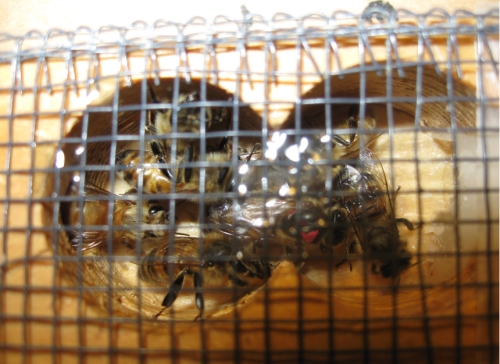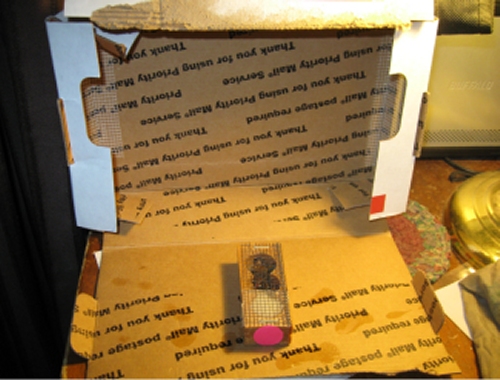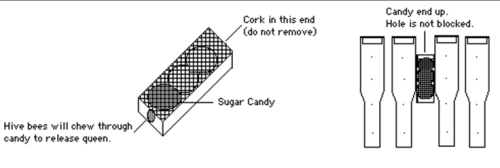
*Splitting a Bee Hive With a New Queen*

About 6 month ago a tragedy happened to one of my beehives. During an extremely windy day a sheet of plywood from a neighbor's yard flew over and struck and knocked over one of my established hives and consequently killed the established queen bee. I didn't realize this until much later as the colonies numbers started to dwindle and eventually it became lifeless.
I placed an order from an apiaries supply company in Ohio for a replacement queen; "The Cordovan Italian queen bees they breed are a very gentle and blond/gold color bee variety of the Italian race. The coloration is caused by a recessive gene and makes the bees all light colored and queens very easy to find! They are raised from select breeder queens and drones that are both Cordovan, and the resulting queens and workers are pure Cordovan. They are available in open mated queens that are mated with my survivor stock of my Ohio and may also have some Russian and Carnolian in them as these drones are also present during mating."
As a courtesy, the breeder marks the queen with a bright non-toxic paint for later identification - and are they hard to find in a colony with upwards of 10,000 bees!
The new queen is shipped by express mail (just about over night) to you in a shipping box with the queen cage attached inside.
Meanwhile, I started to get the new hive ready for her. The first step is to place three brood frames from the established hive. Brood frames are the ones that the queen lays her eggs in and are attended by nurse bees that rarely leave the hive and take care of the eggs and bee larva as they mature. These frames will have both nurse bees and newly hatched workers on them when removed and placed in the new box, this is key to the survival of the new queen and ultimately the survival of the colony.
Next is to give them something to eat; so, two frames of honey will be placed on each side of the brood frames. The box will hold 10 frames altogether, but you will need to leave space for the queen cage so only nine right now.
This split needs to sit for a couple of days for the bees to settle in and let the field bees return to their original hive. The field bees are more aggressive and could sting the new queen through the screened in cage when introduced, so their numbers need to be reduced significantly.
The new hive needs to be moved a good distance from the other to make them think this is their new hive.

Upon arrival, place one drop of pure water on the screen of the cage so the workers can use it to dissolve the candy. Repeat every day the cage is not in the hive. The caged queen can survive several days outside the hive; but, the sooner she is introduced the better. Keep the cage in a dark place away from breezes and at room temperature. It's not uncommon for one or more of the worker bee attendants to have died, this is not a problem.
The queen(s) you have received are in a combination shipping and introduction cage. There is no need to remove the worker bee attendants. Both ends of the cage have corks. Leave the cork in the end with bees. This cage provides food (white sugar candy) during shipment that also acts as a "timed release" barrier for your hive bees to eat through, allowing several days for a pheromone adjustment period.
Important: Avoid keeping queen cages in any room where pesticides are used, especially "NO PEST STRIPS". Also avoid leaving in sunshine. Keep at 65° - 80° F.
The hive to receive the queen must have no queen or queen cells already present. Ideally, the hive should be queenless for at least 24 hours prior to introduction.
Remove the top of the new hive box and place the queen cage on top of the frames in the hive and see what the reaction is of the nurse and new bees is. If they immediately attack or swarm over the cage forming a ball you will need to wait a day longer to introduce her. Let them calm down some more and try again. They will eventually just go on the cage, attracted to her pheromones, and walk around and return to the frames going about their tasks. Now they are more desperate for a new queen and should accept her. There is never a guarantee that they will accept her though, but it is a chance you have to take.
Once you are confident that they are ok with the new queen, you will place the cage as shown in the above line drawing. Always leave the candy end up, so that if one of the attendant bees in the cage dies, they won't block the candy end.
The hive workers will start to remove the candy that plugs the entrance to the queen cage to release her over the next few days, in the meantime feeding the new queen through the screen. Hopefully, now you will have a happy hive and they will prosper and multiply in the years to come.
With the decline of bees in recent years, it will be important for commercial beekeepers (as well as the novice keeper) in propagating bees that are essential for life here on our planet.
My thanks to Mike at MikesBeesAndHoney.com for all of his help and understanding for this novice beekeeper, and for the healthy queen that he supplied.
Bunkerbob
www.alpharubicon.com
All materials at this site not otherwise credited are Copyright © 1996 - 2013 Trip Williams. All rights reserved. May be reproduced for personal use only. Use of any material contained herein is subject to stated terms or written permission.